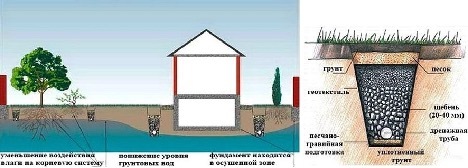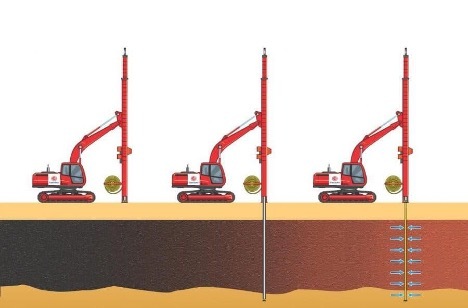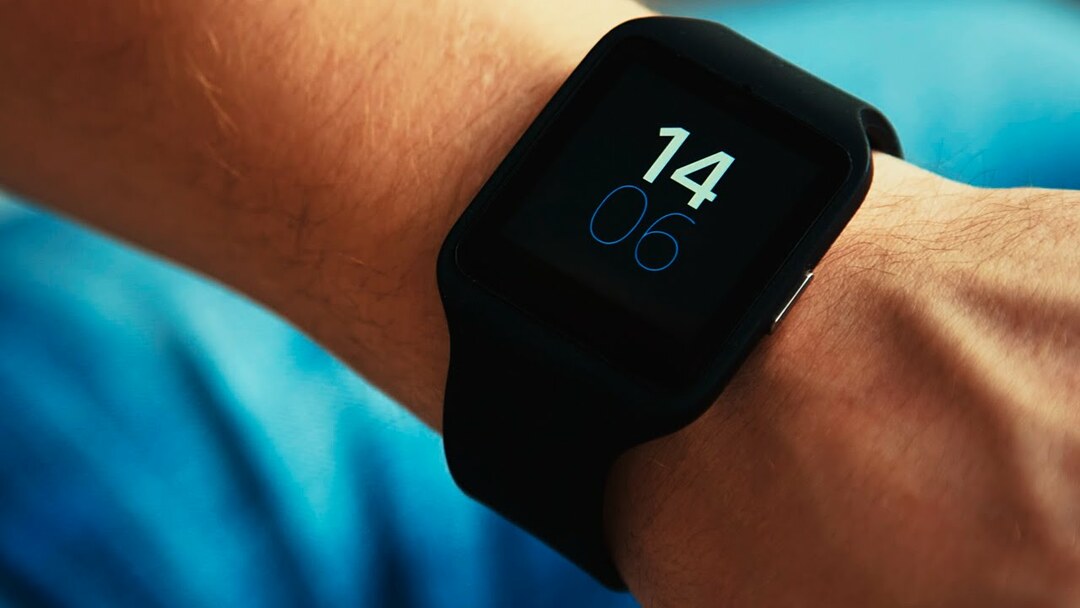In construction, drainage systems play an important role by ensuring efficient water management and protecting buildings from moisture and damage. Understanding the different types of drainage systems and how they work is a key element to a successful construction process. Let's look at how drainage works. We will also look at various types of drainage and drainage systems used in construction.

The content of the article
- Passive drainage
- Vertical drains
- Linear drainage
- Types of drainage in construction: overview
- Mistakes when choosing drainage systems
Passive drainage
Passive drainage is an important engineering system used for efficient water management in construction and agriculture. This type of drainage is based on the natural principles of gravitational flow of water. It also does not require the use of mechanical means such as pumps. Passive drainage is developed taking into account the characteristics of the terrain and soil. This allows for reliable and sustainable removal of excess water.
The main element of passive drainage is drainage pipes or ditches that are laid at a slope in the ground. This allows water to flow freely down the sloped surface and collect in underlying areas. By the way, there it can be further used or allocated. Passive drainage is designed to minimize water accumulation. It also reduces the risk of flooding and damage to soil or buildings.
The advantages of passive drainage include its reliability and low operational complexity. Such systems usually require minimal maintenance. They also do not rely on electrical power or mechanical devices. And this is what makes them cost-effective and durable solutions for water control in a variety of conditions.
Vertical drains

They represent an important element of drainage systems used in construction and agriculture. Used to control groundwater levels and prevent excess moisture from penetrating into the soil. This type of drainage differs from horizontal systems in that it involves vertically installed drainage pipes or wells that penetrate deeper into the soil.
The operating principle of vertical drains is based on the fact that they create channels or wells in the ground, through which excess water can penetrate into deeper horizons or be pumped out to surface. These drainage features are usually equipped with drain holes. They can also be made from various materials. Possible options:
- plastic;
- concrete;
- special drainage fabrics.
Vertical drains are often used in cases where horizontal drainage systems are not effective enough. For example, they are used when the groundwater level is high. They can be used both for agricultural purposes and in construction. Their use ensures the stability of foundations and prevents moisture from penetrating into underground spaces.
However, it should be noted that the installation of vertical drains requires professional skills and knowledge of the hydrogeology of the area. Only this will help you determine the optimal location and depth. The effective use of vertical drains can significantly improve the efficiency of the drainage system. It also allows for reliable control over groundwater.
Linear drainage
This is an engineering system designed to collect and drain surface water. By the way, it is this material that is widely used in construction and landscape architecture. This type of drainage is based on the creation of special ditches or gutters laid along certain areas of the ground. The main purpose of linear drainage is to prevent water from pooling and stagnating on the surface, which can lead to various problems such as flooding and soil erosion.
Linear drainage can be especially useful in uneven areas. It is also used in places where water tends to accumulate. The system consists of special drainage channels or gutters. They can be made of various materials such as concrete, plastic or metal. These channels are usually laid on the surface of the ground and equipped with drainage holes through which water is collected and discharged.
The benefit of linear drainage is that it helps maintain the balance of water in the area, preventing negative consequences such as damage from water runoff. Additionally, it can be an effective means of preserving landscaping as channels are easily integrate into the environment and can be hidden under decorative elements such as lawns or sidewalks.
Types of drainage in construction: overview
In construction, there are many types of drains and drainage systems that can be selected depending on specific needs and conditions. Here are some of the most common types of drains:
- Subsurface drainage involves the use of drainage pipes and sewers installed underground to collect and drain groundwater.
- Surface drainage involves creating ditches, gutters, or paths to carry away surface water.
- Drying drainage is used to control groundwater levels and keep basements and building foundations dry.
- Agricultural drainage is used in agriculture to control water levels in fields and prevent oversaturation of the soil.
- Horizontal drainage involves laying drainage pipes horizontally along areas to collect and drain water.
Mistakes when choosing drainage systems
One of the common mistakes is insufficient study of the hydrogeology of the site before choosing a drainage system. Unaccounted for soil and groundwater features can lead to an ineffective system.
An incorrectly selected type of drainage system, such as horizontal, vertical or linear, can lead to insufficient water management.
Another mistake is the lack of consultation with drainage specialists, which can lead to incorrect design and installation of the system.
Choosing cheap and low-quality materials can lead to corrosion or degradation of the system, requiring replacement or repair. And the wrong depth of placement of drainage elements can lead to insufficient water collection or even its absence.
Unheeded local building codes and permits can lead to legal problems and the need to redesign the system.
Just believe that avoiding these mistakes when selecting and installing a drainage system can ensure its effectiveness and longevity in managing water on your property.
Depending on specific conditions and tasks, the choice of type of drainage system can vary significantly. Regardless of the type chosen, a properly designed and installed drainage system will ensure effective water management and protection of construction sites from moisture.


